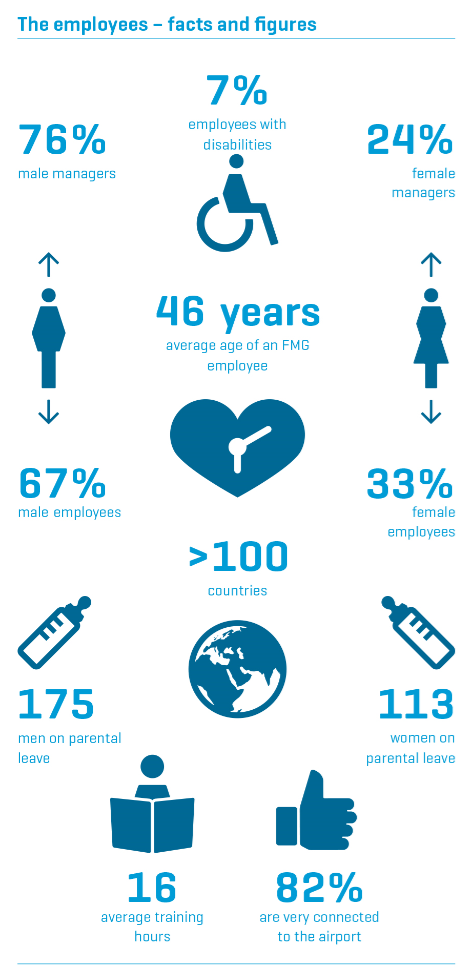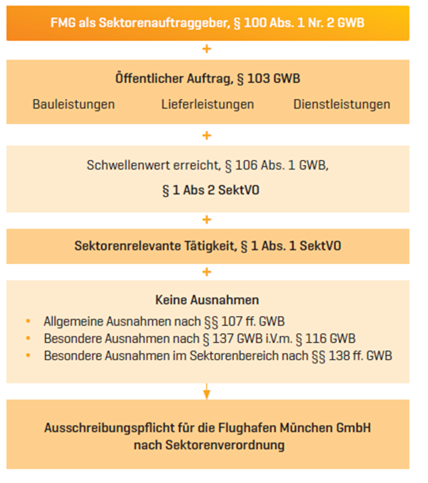The long-term human resources concept is geared toward the wider corporate strategy, the current business situation, and
broader trends within society such as demographic change, digitalization, individualization, mobility, health, and education. The human resources strategy sets out important objectives (see criterion 14) for HR management, which are reviewed annually and adjusted as required.
Generation change as a major challenge
Currently, the greatest HR challenge facing the company is demographic change. In order to meet the higher personnel requirements caused by the large waves of age-determined retirements expected over the coming years, it is absolutely essential that the airport’s employer attractiveness be boosted in the competitive labor market of the region. Munich Airport is therefore committed to responding to the values of younger generations and the expectations they have for their everyday professional lives. As an employer, the airport wants to actively shape this cultural change and, at the same time, guarantee the knowledge transfer between experienced and new employees. This is a matter of cleverly dovetailing the consequences of the generational change, on the one hand, and the changes in the workplace caused by digitalization and process optimization on the other. In this way, it will be possible to work efficiently, while deploying personnel in a manner appropriate to the requirements, and to offer attractive employment conditions for all generations of the airport family.
Commitment to the next generation The Munich Airport Group is one of the largest training organizations in the region. School leavers have the choice of 20 different apprenticeships and dual fields of study. Flughafen München GmbH received 1,635 applications for the apprenticeships starting in 2018. On September 1, 2018, 97 apprentices embarked upon their professional career at Munich Airport. This meant there were 277 young people taking part in apprenticeships Group-wide as of the reporting date of December 31. At the same time, 46 young people completed their apprenticeships at FMG. A further 84 school-age children and 123 university interns received an insight into the world of airports, producing 17 project-related Bachelor’s and Master’s dissertations in the process. In a twelve-month graduate training program, university graduates received an effective preparation for professional life at the airport. This includes both specialist knowledge and an understanding of the complex overall system that is the airport. A mentoring program helps trainees to establish their own company-wide network.
Focusing on family and health Group management is convinced that good performance and a family-friendly working environment are mutually dependent. FMG has for many years placed a high priority on being family friendly and has supported this with numerous offerings. Moreover, much of the airport’s work in this area aims to maintain or improve staff ability to work. The Corporate Health and Social Management (BGM) division offers a wide array of services, ranging from occupational medicine and employee catering to advice for people living in difficult circumstances. The Munich Airport Group offers a range of supplementary company benefits for a healthy work/life balance. For example, more than 700 employees utilize the offer to work up to 30 percent of their individual working hours from their home or mobile office.
Catering in the employee canteens 900,000 meals are served annually in the five employee canteens on the airport campus. The goal of the canteen concept is to offer employees well-balanced meal options in a pleasant environment. In 2018, the canteen in Terminal 2 was completely renovated and re-opened with the theme «Mediterranean meets Art».
Support for longer-term illness phases As at January 1, 2019 a new works agreement for occupational integration management (BEM) came into effect. It regulates the processes around the voluntary procedure for employees, who were off sick for more than six weeks within a period of a year and then return to their workplace. The program counteracts future incapacity to work and contributes to maintaining employability.
Musculoskeletal program «Aufwind» 30 percent of all illness-related days of absence in FMG between 2013 and 2017 are attributable to problems with the musculoskeletal system. For this reason, Corporate Health and Social Management implemented a holistic prevention program, aimed at reducing chronic musculoskeletal disorders, maintaining the ability to work, and thus improving productivity. As part of this program, the FMG occupational medicine service also works closely with external physiotherapists.
Occupational protection FMG has set itself the goal of continuously improving working conditions, and of lowering the accident and illness figures. New solutions are constantly being developed at Munich Airport to counteract health hazards and risks in the workplace. The first Group-wide workplace safety committee meeting, held in 2018, provided the opportunity to exchange ideas, information, and opinions on cross-Group topics such as safety standards, accident prevention strategies and health care. Around 70 managers, works council members, specialists in occupational health and safety, and safety officers from the subsidiaries took part in the event.
Occupational safety conference at Munich Airport A high safety level in the ground handling service is only guaranteed through close, cross-department cooperation in the area of occupational health and safety. Some 30 specialists from the field of occupational health and safety along with safety officers from the subsidiaries, managers, work council members, and chief executive officers of external ground handling operators met in 2018 at an occupational health and safety conference held at the Airport Academy to discuss the role of managers in relation to occupational health and safety and the possibilities for improving communication between and with employees on the apron. The aim was to identify fields of action and to derive measures together, in order to minimize hazards and avoid accidents. An occupational safety conference was set to take place again in 2019.
«Common task, common responsibility» annual report 2017 saw the first publication of a
joint annual report of the occupational health and safety, in-house health management and company medical service divisions. Ergonomics One of the core tasks of the Occupational Health and Safety division is the design of ergonomic workstations. In particular, aircraft ground services staff perform challenging physical activities with a verifiably heightened risk of musculoskeletal disorders. In 2018, FMG invested in a study conducted in cooperation with the Fraunhofer Institute into developing an automatic, robot-controlled baggage loading system. The aim is to significantly reduce the manual activities of employees in aircraft ground handling. Further concrete project steps are planned for 2019.
Outlook The Occupational Health and Safety division works closely with the Airport Academy – for example, on the development of web-based training for occupational health and safety-related topics. In 2018, the review of FMG’s in-house occupational health and safety management system by the Trade Supervisory Office was of paramount importance; certification was planned for 2019.
Numerous prospects for employees with impaired health FMG possesses a great deal of expertise in the employment of people with impaired health. In order to facilitate as normal an everyday working life as possible, a range of offers is provided: occupational integration management, the continued employment of employees whose abilities have changed, the recruitment of people with severe disabilities, and the training of young adults whose intellectual development must be supported. As at Monday, December 31, 2018, the Group employed 698 staff members with disabilities or equivalent limitations, corresponding to around seven percent of the total workforce.
Back health – lifting aids in the baggage transportation system Lifting aids have been installed on all work stations on the baggage transportation system in Terminal 1. Working with the relevant divisions, various loading tools were tested and assessed beforehand. The aim of the lifting aids is to help prevent chronic musculoskeletal disorders. Furthermore, they help employees with impaired health to return to work.
Living space for employees The demand for living space in the airport region is growing constantly. At the same time, Munich Airport must – within the framework of its social responsibility – ensure the future personnel requirements, which also includes strategies to support employees in finding accommodation. Depending on demand, the airport offers its staff separate 1- and 2-person apartments, rooms in shared accommodation, and apartments in apartment blocks. Capacity for a total of 500 employees will be available by fall 2019, with additional to follow.
Airport Academy: Experts in education and training Munich Airport operates a certified, in-house training center with just under 50 employees. On more than 38,000 participant days, 26,700 Group employees and external customers attended seminars there, focused particularly on the areas of human resources, management, aviation, and security. Digital training formats via a learning management platform are a fixed component of the offering, including, for example, the cross-Group safety management training as part of the EASA certification of the airport. The Airport Academy, moreover, offers training for an international audience, as an accredited training institute of the Airports Council International (ACI) – in cooperation with the international umbrella association of passenger airports. For example, more than 100 external cyber security specialists completed training in four different seminar types at the Information Security Hub, which opened on the airport campus in early 2018.
The HR Development and Executive Support department, in its advising and conceptual role, supports the strategy as well as short-term and medium-term orientation of the company. In this process, Human Resources uses various instruments to select and develop employees and management staff.
To ensure quality, the HR Development and Executive Support department also performs a governance role.
Examples of further training measures are: The AMPAP development program The AMPAP program (Airport Management Professional Airport Accreditation Program) is a concurrent further education program from ACI/ICAO for the purposes of expanding airport management skills.
Graduate training program HR Development offers trainee positions to ensure the acquisition of new, junior staff. On the one hand, junior staff are to acquire specialized knowledge in the field. On the other hand, they are to understand the complex overall system of the airport, know important interfaces, and be able to contribute to projects and overarching topics in a competent manner.
Qualification dialog Every employee can discuss their training ideas and wishes in a qualification dialog with their direct manager. Management examines these suggestions and gives the employee binding feedback by the annual employee appraisal at the latest.
Exchange program Trainees, employees, and managers have the opportunity to expand their professional and social skills in national or international exchange programs, in addition to individual training opportunities. With the Airport Academy, Munich Airport operates a certified, Group-owned training unit that handles operational personnel topics like training, coaching, and team development.

